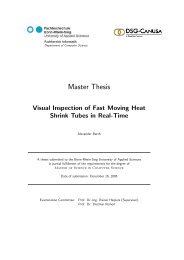Master Thesis - Hochschule Bonn-Rhein-Sieg
Master Thesis - Hochschule Bonn-Rhein-Sieg
Master Thesis - Hochschule Bonn-Rhein-Sieg
You also want an ePaper? Increase the reach of your titles
YUMPU automatically turns print PDFs into web optimized ePapers that Google loves.
3. Hard- and software <strong>Master</strong> <strong>Thesis</strong> Björn Ostermann page 27 of 126<br />
c being the speed of light<br />
f being the used modulation frequency<br />
c 1<br />
� � camera range<br />
f 2<br />
m<br />
299 792 458<br />
s 1<br />
� � 7.<br />
5m<br />
20MHz<br />
2<br />
Equation 2: Calculation of the maximum range<br />
Longer ranges would theoretically be possible by choosing other modulation frequencies. Due to the<br />
physical restrictions of the used sensor chip (saturation time, etc.) 7.5 meters is the maximum range<br />
for which the camera is usable, according to the manufacturer [55].<br />
The advantage in using near infrared light is that the every other part of the spectrum, including the<br />
visible light, can be filtered out before measuring.<br />
The camera’s main characteristics are summarized in Figure 12, additional information can be found<br />
in the first project report [77].<br />
Model No. SR-3100<br />
Pixel array resolution 176 x 144 pixels<br />
Field of view 47.5 x 39.6 degrees<br />
Non-ambiguity range 7.5 m<br />
Frame rate Variable, max 50fps<br />
Estimated Error 1% of measured distance<br />
Figure 12: Table containing Camera Data, taken from [55]<br />
As shown in the first project [77], recognition of the humans hand is assured for a distance of up to<br />
three meters.<br />
Detailed studies on the accuracy of the camera have been done by another BGIA project [80]. Their<br />
result is that the camera’s accuracy does not depend on temperature in a range between -10°C and<br />
+50°C. The camera delivers sufficiently reliable and repeatable results in a distance between 2 and 5<br />
meters, provided that no material is present that does absorb most of the emitted light wave.<br />
In the studies of this project only two materials (a grey jeans and a black shirt) have been found that do<br />
not reflect the emitted waves sufficiently. In the case of the given application, this problem can be<br />
handled as described in chapter 7.2.














